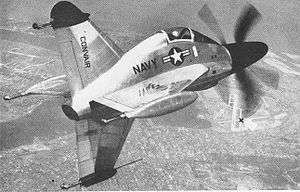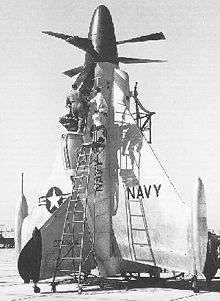Convair XFY Pogo
| XFY Pogo | |
|---|---|
 | |
| Role | Experimental VTOL fighter aircraft |
| Manufacturer | Convair |
| First flight | 19 April 1954 (tethered) 1 August 1954 (free flight) |
| Primary user | United States Navy |
| Produced | 1954 |
| Number built | 3 (only 1 flown) |
|
| |
The Convair XFY Pogo tail-sitter was an experiment in vertical takeoff and landing. The Pogo had delta wings and three-bladed contra-rotating propellers powered by a 5,500 hp (4,100 kW) Allison YT40-A-6 turboprop engine. It was intended to be a high-performance fighter aircraft capable of operating from small warships. Landing the XFY-1 was difficult, as the pilot had to look over his shoulder while carefully working the throttle to land.
Design and development
After World War II, the Cold War prompted the United States Army and Navy to study VTOL operations. It was envisaged to protect task forces, convoys or any fleet, even without aircraft carriers, by placing VTOLs on any ship. These fighters would be housed within a conical protective housing, saving limited deck space available aboard ships. They would provide first line of airborne defense and reconnaissance capability, before more aircraft could be scrambled to help.[1]
In May 1951, Lockheed and Convair were awarded contracts in the attempt to design, construct, and test two experimental VTOL fighters that would be suitable for use by the Armed forces. Although contract stipulations stated that each manufacturer have two fighters, each was only able to construct one, with Lockheed producing the XFV, and Convair producing the XFY, nicknamed the "Pogo". The first XFY-1 prototype was used for engine testing and the third for static testing and only the second prototype serial number 138649 was flown.[2]
The XFY-1 was designed for the Allison YT40-A-14 turboprop expected to deliver 7,100 shp (5,295 kW), the production aircraft were intended to use the even more powerful Allison T54 which was never built.[3] It had delta wings, swept at 52 degrees, and a fin with a span of 21 ft 8 in (6.5 m). The pilot's seat was mounted on gimbals allowing for movement from 45 degrees in vertical flight to 90 degrees in horizontal flight. The Curtiss-Wright Turbo-electric co-axial contra-rotating three-bladed propellers were 16 feet (4.88 m) in diameter.[4]
Operational history
Testing and evaluation



On 19 April 1954, a Convair engineering test pilot and Marine reservist, Lieutenant Colonel James F. "Skeets" Coleman, made the first tethered flight in the Pogo. The XFY-1 was like no other propeller driven aircraft before it. No previous aircraft with a similar weight, engine power, or size had ever attempted to take off and land vertically. For the safety of both the craft and its pilot, the propeller hub cover was removed and replaced by safety tether lines for the first flight, in case Coleman would lose control of the craft and would need to be tethered to prevent the craft falling to the ground. On the other end of the tether was another engineer, Bob McGreary. If Coleman ever lost control, McGreary controlled the winch which could be turned to raise the tethers to prevent the craft from plummeting to the ground. For further safety precautions, four security cables were fastened to each wing in case control was lost in any axis. The tests were conducted inside of a naval airship hangar at Moffett Field in Mountain View, California.[5]
Throughout the next few weeks, Coleman logged almost 60 hours in test flights in the Pogo, and by August, the test was moved to outdoor conditions. On 1 August 1954, Coleman logged two outdoor test flights, the second flying 150 ft (50 m) into the air, and shortly after he flew 70 takeoff–landing drills at the Naval Auxiliary Air Station in Brown Field, California.[6] The first conversion to horizontal flight took place on 5 November 1954.[7][N 1]
Upon later flights with longer durations, flaws in the design were found. Due to the Pogo's lightweight design, and the lack of spoilers and air brakes, the aircraft lacked the ability to slow down and stop efficiently after moving at high speeds. Landing was also a problem, as the pilot had to look back behind himself during a landing to properly stabilize the craft.
It became evident that even if technical problems could be overcome, such VTOL aircraft would be flown only by the most experienced pilots. Thus, it was not feasible to place VTOL fighters—as previously hoped for—on every ship. Also, whereas jet-engined fighters had top speeds that approached Mach 2, the turboprop VTOL fighter was at a disadvantage with a top speed around Mach 1. Due to these problems, the XFY Project was put on hiatus.[10]
Later testing
Although a test flight was made on 19 May 1955, it again ended with failure, and on 1 August 1955 the project was formally concluded. The last flight of the Pogo took place in November 1956.
Survivors
After several years on static display at Naval Air Station Norfolk, Virginia, the Pogo was moved to the National Air and Space Museum in Suitland, Maryland, where it currently resides.[11]
Specifications (XFY-1)
Data from Yenne, Bill. Convair Deltas from SeaDart to Hustler. Specialty Press: North Branch, MN, 2009. ISBN 978-1-58007-118-5.
General characteristics
- Crew: 1
- Length: 32 ft 3 in (9.8 m)
- Wingspan: 27 ft 8 in (8.4 m)
- Height: ft in (m)
- Wing area: 355 ft² (33 m²)
- Empty weight: 11,139 lb (5,060 kg)
- Useful load: 13,250 lb (6,016 kg)
- Loaded weight: 14,250 lb (6,470 kg)
- Max. takeoff weight: 16,250 lb (7,370 kg)
- Powerplant: 1 × Allison YT40-A-6 turboprop engine, 5,100 shp (3,803 kW)
- Propellers: 3-bladed contra-rotating propellers
Performance
- Maximum speed: 474 mph (412 kn, 763 km/h) at 15,000 ft (4,600 m)
- Range: ≈500 mi (308 nmi, 805 km)
- Service ceiling: 37,500 feet (11,440 m)
- Rate of climb: 9,980 ft/min to 20,000 ft (3,045 m/min)
- Max. wing loading: 38.1 lb/ft² (186 kg/m²)
- Minimum power/mass: 0.34 hp/lb (560 W/kg)
Armament
- Guns: 4 × 20mm (0.79 in) cannon, or
- Rockets: 48 × 2.75 in (70 mm) Mk 4 Folding-Fin Aerial Rockets
See also
- Aircraft of comparable role, configuration and era
- Related lists
- List of experimental aircraft
- List of fighter aircraft
- List of military aircraft of the United States
References
- Notes
- Citations
- Bibliography
- Allen, Francis J. "Bolt Upright: Convair's and Lockheed's VTOL fighters". Air Enthusiast (Key Publishing) Volume 127, January/February 2007, pp. 13–20. ISSN 0143-5450.
- Rogers, Mike. VTOL: Military Research Aircraft. New York: Orion Books, 1989. ISBN 0-517-57684-8.
- Taylor, Michael. The World's Strangest Aircraft. London: Grange Books plc, 1999. ISBN 1-85627-869-7.
- Taylor, John W. R. & Michael J. H. Jane's Pocket Book of Research and Experimental Aircraft. Collier Books: New York, 1977 ISBN 0-356-08405-1.
- Winchester, Jim. "Convair XFY1 'Pogo'." Concept Aircraft: Prototypes, X-Planes and Experimental Aircraft. Kent, UK: Grange Books, 2007 [2005]. ISBN 978-1-84013-809-2.
- Yenne, Bill. Convair Deltas from SeaDart to Hustler. Specialty Press: North Branch, MN, 2009. ISBN 978-1-58007-118-5.
External links
| Wikimedia Commons has media related to Convair XFY. |
- The National Air and Space Museum Web page for the Pogo.
- This short YouTube clip shows the XFY-1 takeoff, transition, and landing.
- This longer (nine-minute) clip shows testing of the XFY-1 in an airship hangar, and extended takeoff, flight and landing sequences.
- "Heads Up Fighters." Popular Mechanics, May 1954, pp. 96–97.